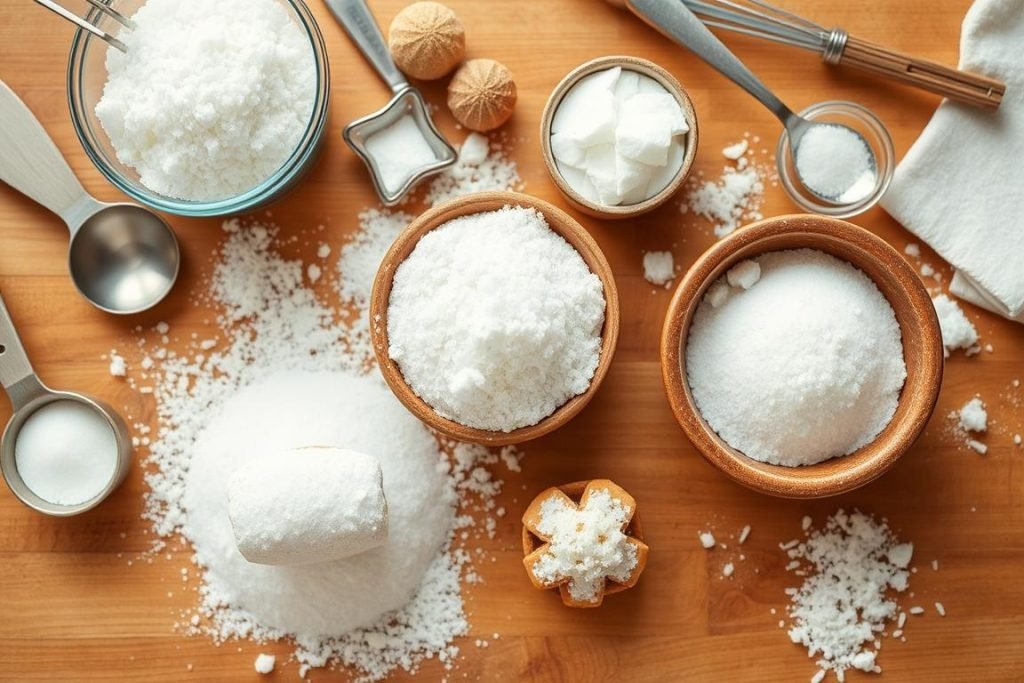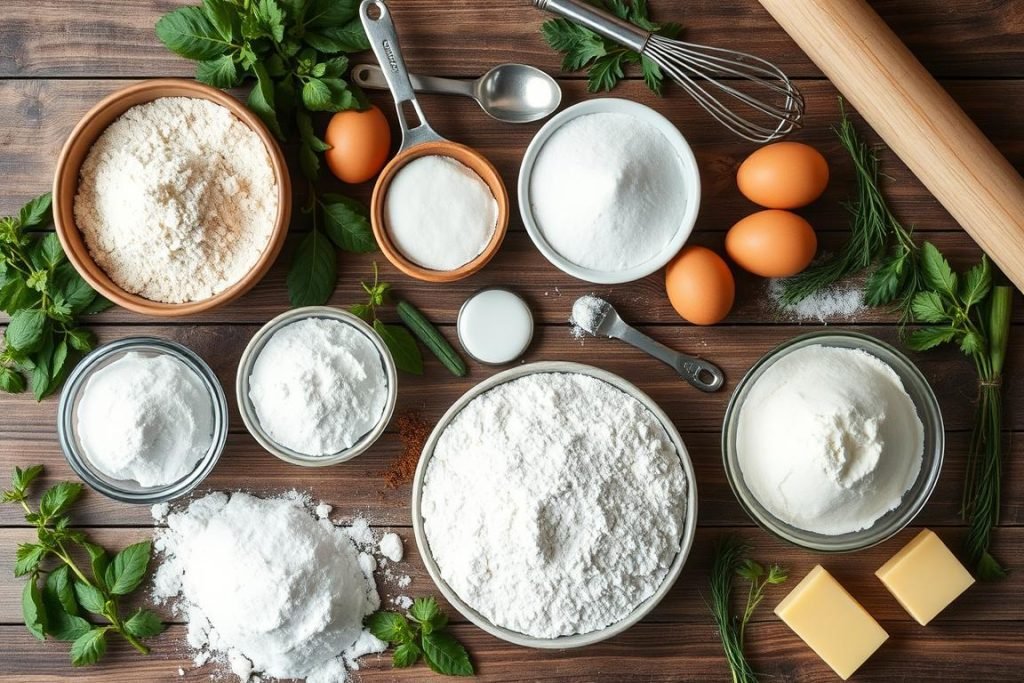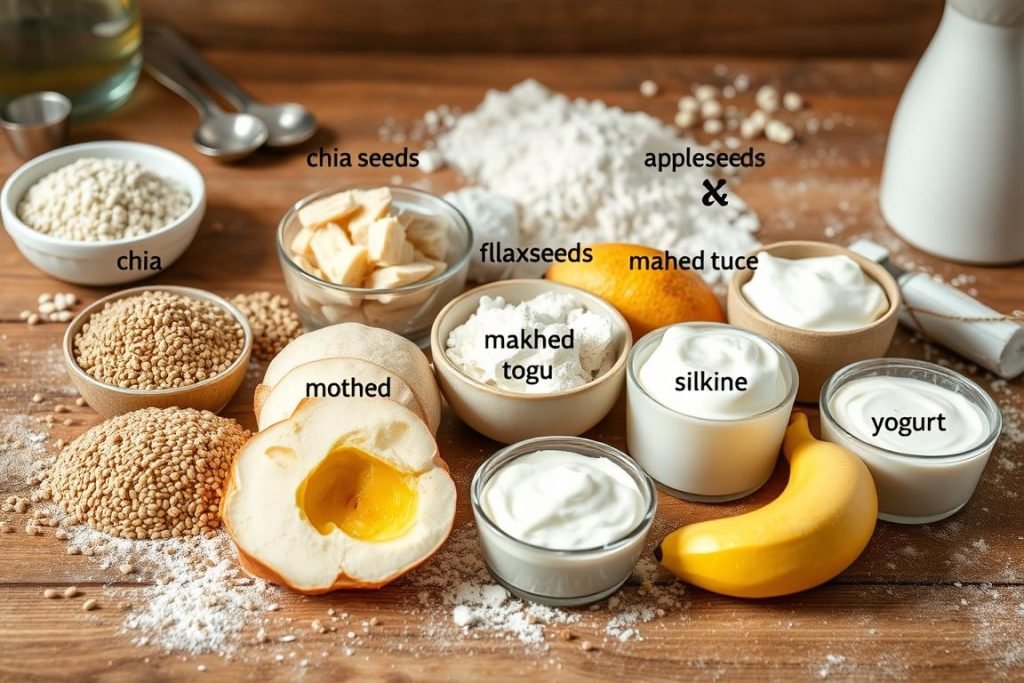Essential Ingredients for Baking Success

Have you wondered about the secret to perfect baked goods every time you bake? Whether you’re new or experienced in baking, knowing the baking basics list is key. There are nine fundamental ingredients for baking you’ll need for nearly every recipe.
Imagine the smell of fresh cookies or the perfect sponge cake. You start with essential basic baking ingredients. Flour, leaveners, and sugars are just the start. They’re like your paint, and your whisk is the brush that brings them to life. Now, let’s learn about these items and how to use them well.
Key Takeaways
- Understand the nine essential ingredients needed for a well-equipped baking kitchen.
- Discover the three main categories of foundational baking elements: flour, leaveners, and sugars.
- Learn the importance of storing various flour types properly to ensure longevity and quality.
- Gain insight into how leaveners like baking soda and baking powder chemically affect your baking.
- Explore the diverse types of sugars and the distinct qualities each brings to your baked goods.
- Embrace pure, quality flavorings, like actual vanilla extract, to elevate the taste of your creations.
- Recognize the standard ingredients such as large eggs and unsalted butter essential for most baking recipes.
Understanding Basic Baking Ingredients
When you start baking, knowing and using key baking ingredients matters a lot. Your baked goods, like fluffy cakes and crusty bread, depend on these ingredients.
What Are Basic Baking Ingredients?
A baking basics list is found in many recipes. It usually has flours, sugars, fats, eggs, salt, and leavening agents. These primary baking supplies are the start of classic baked items. Flours create structure, fats add moisture and texture, and sugars sweeten while changing color and texture.
Importance of Quality Ingredients
Using top-notch common baking essentials is a must for the best results. Good flour helps with gluten, which is needed for great bread and cakes. Also, fresh, strong yeast can make or break a loaf’s rise.
Types of Ingredients Used in Baking
The key baking ingredients vary to give you certain results:
- Flours: You have all-purpose flour and others like bread flour and cake flour for special textures.
- Fats: Butter, shortening, and oils add different tastes and textures, with butter being very popular.
- Leavening Agents: Baking soda and baking powder make cakes and cookies light and airy by releasing gas.
- Sugars: Sugar varieties change the sweetness and moisture of treats, with many types available.
- Eggs: Eggs help with structure, leavening, richness, and color in baking.
Knowing these ingredients and how they work together is key. It’s not just about sticking to a recipe. It’s about becoming skilled at baking. No matter if you’re new or experienced, learning about these essentials will make your baking better.
Flour: The Foundation of Baking
Flour is a must-have baking ingredient for all. It is important for many recipes, for beginners and experts. Knowing about different flours helps make your baked goods better.
Various Types of Flour
All-purpose flour is great for many recipes. It’s strong but still tender. Specialty flours meet specific baking needs. For example, bread flour makes chewy bread, and cake flour makes light sponges. Gluten-free flour is great for those with allergies. Brands like Bob’s Red Mill and King Arthur Flour make tasty gluten-free options.
How to Choose the Right Flour for Your Recipe
Picking the right flour is important for your baking. It affects texture, flavor, and how it holds together. Here’s a quick guide:
- For heavy, rustic breads, choose whole wheat flour.
- Low-protein, finely milled flours are best for pastries and cakes.
- All-purpose flour works great for thickening sauces or soups.
- For a gluten-free diet, try blends with rice or almond flour.

| Type of Flour | Protein Content | Best Use |
|---|---|---|
| All-Purpose Flour | Medium | General baking |
| Bread Flour | High (approx. 13%) | Breads and yeasty bakes |
| Cake Flour | Low | Cakes and delicate textures |
| Gluten-Free Flour | Varies | Gluten-free recipes |
Learning about flours can improve your baking. Whether you use all-purpose flour, specialty flours, or gluten-free flour, each type enriches your baking. They enable you to create wonderful things in the kitchen.
Sugars: Sweetening Your Baked Goods
Entering the baking world? Learn about sugars to boost your baking. Knowing your sugars, granulated, brown, or confectioners’, can be a game changer. It matters whether you’re starting or perfecting recipes.
Types of Sugar: Granulated, Brown, and Powdered
Different sugars add unique touches to sweets:
- Granulated Sugar: The most common sugar. It sweetens and gives structure. It’s great for mixing into batters.
- Brown Sugar: It’s granulated sugar with molasses added. Brown sugar brings moisture and depth. Great for cookies and moist cakes. You can pick light or dark based on the molasses content.
- Confectioners’ Sugar: Also known as powdered sugar. Made smooth and mixed with cornstarch to stop clumps. Perfect for frostings and dustings.
Understanding Sugar’s Role in Baking
Sugar does more than sweeten. Here’s its magic:
- Caramelization: Heating sugar makes it brown. This gives desserts flavor and color. It’s key for tasty crusts and cookies.
- Moisture Retention: Sugar keeps treats moist longer. It’s a must for soft cookies.
- Leavening: Mixed with baking soda, it helps dough rise. It’s a baking booster.
- Texture: Sugar makes treats tender by messing with gluten. This means softer cakes and pastries.

Dive into sugar science to improve your baking. Each time, pick the right sugar for taste and texture. Granulated for daily bakes, brown for chewy cookies, or confectioners’ for smooth frostings. They all have their special spot in your pantry.
Fats: Adding Flavor and Texture
Fats are key in essential baking supplies. Each type brings its own flair. This impacts the taste and feel of what you bake. Using the right fat, like unsalted butter or vegetable oil, is crucial. It makes your baking texture just right.
Types of Fats for Baking: Butter, Oil, and Shortening
Each fat has its perks. Unsalted butter adds a rich taste and creamy feel, perfect for pastries. Vegetable oil helps make cakes and muffins moist and tender. For flaky textures in pie crusts and cookies, Shortening is best. It’s all fat.
The Science Behind Fat in Baking
Fats interact with other ingredients in special ways. Creaming unsalted butter with sugar helps add volume. It makes cakes and cookies fluffy. Vegetable oil keeps things moist and extends shelf life. Shortening keeps cookie shapes perfect by not spreading too much.
Learn about different fats and their uses:
| Fat Type | Characteristics | Common Uses |
|---|---|---|
| Unsalted Butter | 80-82% fat content, creamy flavor, solid at room temperature | Pastries, cookies, frostings |
| Shortening | 100% fat, neutral flavor, solid at room temperature | Pie crusts, cookies |
| Vegetable Oil | 100% fat, liquid at room temperature, neutral flavor | Cakes, muffins, quick breads |
Picking the right fat matters for taste, texture, and structure. Knowing about fats lets you explore new tastes and textures. Your baked goods will show off your skills.

Leavening Agents: Making Your Baked Goods Rise
When baking, leavening agents are key. They make baked goods light and airy. Knowing about chemical leavening and biological leaveners ups your baking game.
Common Leaveners: Baking Powder vs. Baking Soda
Baking soda and baking powder are common chemical leaveners. Baking soda reacts with acids like buttermilk. This makes carbon dioxide gas and helps dough rise. It’s perfect for quick breads and pancakes.
Baking powder has both an acid and a base. It reacts twice, once with moisture and again with heat. This lets your goodies rise evenly during baking.
Biological leaveners such as yeast are crucial in bread making. Yeast makes dough rise and adds to the flavor. It turns sugars into carbon dioxide and alcohol, expanding the dough.
How to Store Leavening Agents Properly
Storing leavening agents right is key. Keep chemical leaveners like baking soda and baking powder cool and dry. Yeast, a biological leavener, lasts longer in the fridge or freezer.

To check baking soda’s power, mix it with some vinegar. If it fizzes, it’s good. For baking powder, mix it with warm water. No bubbles mean it’s time for a new one. These tests help ensure your baked goods don’t fall flat.
| Leavening Agent | Type | Common Use | Shelf Life |
|---|---|---|---|
| Baking Powder | Chemical | Cakes, Biscuits | 18-24 months |
| Baking Soda | Chemical | Cookies, Quick Breads | 18-24 months |
| Yeast | Biological | Breads, Rolls | Up to 4 months (refrigerated) |
| Cream of Tartar | Chemical | Meringue, Whipped Cream | Indefinite |
Summing it up, knowing and storing leavening agents right is a huge deal in baking. By keeping chemical leavening agents and biological leaveners like yeast ready, you’re set for baking success.
Eggs: Binding and Leavening Agents
Eggs are very important for many recipes. They are a must-have for your baking basics list. Eggs work as binding ingredients and help things rise. Knowing how eggs work can make your baking better. This is true when you use large eggs. Most recipes assume this size.
The Role of Eggs in Baking
Eggs do important jobs in baking. Think about meringues, quiches, and sponge cakes. They mix ingredients well together. This makes everything stick together. The fats in large eggs make flavors better and softens textures. Egg yolks have something special that keeps batters and doughs perfect. Whisking eggs puts air inside. This air makes baked goods light and fluffy when baked.
Substituting Eggs in Recipes
Sometimes you can’t or don’t want to use eggs. You might not have any or are baking for someone special. Using egg substitutes can still give you great results. Things like apple sauce, mashed bananas, and special egg replacement products are good choices. These are especially popular for vegan baking or reducing cholesterol.
Here’s a look at how these egg substitutes compare to real eggs:
| Substitute | Best Used For | Comparable to Large Egg |
|---|---|---|
| Apple Sauce | Moist cakes, muffins | Binding, not leavening |
| Mashed Banana | Sweet breads, brownies | Binding, mild leavening |
| Commercial Egg Replacer | General baking | Binding and leavening |
Think about what role eggs played in your original recipe. This helps decide the best egg substitute to use. The goal is to keep the food’s texture and taste as intended.

Getting good at using these substitutes makes baking more fun. You can be creative and include everyone, no matter their diet or what you have in the kitchen.
Dairy Products: Enhancing Flavor and Moisture
Dairy for baking like butter, milk, and buttermilk are key. They boost flavors and textures in baked goods. They make the taste richer and add the moisture needed for a soft crumb in breads and cakes.

Common Dairy Ingredients Used in Baking
People have loved dairy in cooking for ages, including in baking. Buttermilk brings a tangy flavor and helps make textures airy. Butter adds richness in taste. Milk is a must-have, the USDA says to have it 2-3 times a day. It’s great in everything from simple cookies to big cakes.
Non-Dairy Alternatives for Baking Success
If you can’t have dairy or choose not to, there are good options. Plant-based milks like almond, soy, or coconut milk work well. These can replace dairy milk one-for-one. But, they might taste and feel a bit different. They meet your dietary needs and still give good baking results.
| Dairy Product | Function in Baking | Non-Dairy Alternatives |
|---|---|---|
| Butter | Flavor enhancement, texture | Plant-based butters, coconut oil |
| Milk | Moisture, structure | Almond milk, soy milk |
| Buttermilk | Leavening reaction, flavor | Almond milk with vinegar, soy milk with lemon juice |
Knowing about dairy and its alternatives is key for any baker. It helps make recipes everyone can enjoy. As baking changes, these ingredients stay important for all kinds of baking.
Flavorings and Spices: Elevating Your Bakes
Every baker knows the secret to yummy baked goods isn’t just sugar and flour. It’s also the magic touch of flavorings and spices. Things like vanilla extract make baking go from good to great.
Popular Flavoring Ingredients to Consider
Vanilla extract is a must for cookies and cakes. It makes flavors rich and warm. But don’t stop at vanilla. Try almond, lemon, or peppermint for a special twist.
Cinnamon, nutmeg, and ginger are key for a spicy touch. They’re great for cinnamon rolls or ginger cookies. These spices add special flavors and make your kitchen smell amazing.
How to Use Spices in Baking
Adding spices to recipes can be easy with these tips. Start small, since you can’t take it back once it’s in. Mix spices with dry stuff like flour before mixing with wet stuff for even flavors.
Here’s a guide to using spices:
| Spice | Description | Common Uses |
|---|---|---|
| Cinnamon | Sweet and woody, good for sweet and savory | Cakes, pastries, and apple pies |
| Nutmeg | Rich, warm, grate it fresh | Puddings, custards, and cookies |
| Ginger | Peppery, sweet, with a bite | Gingerbread, pumpkin pies, and muffins |
| Cloves | Strong, pungent, and sweet | Spice cakes and holiday pastries |
| Allspice | Likes cinnamon, nutmeg, and cloves | Jamaican food, desserts, and stews |
Keep your spices in a cool, dark spot. Use glass containers to keep them fresh longer.

With some practice, you’ll get great at using vanilla extract and spices. Your baked goods will taste and smell unforgettable.
How Can Essential Ingredients Impact the Secret Tips for Baking Perfection?
Essential ingredients play a crucial role in mastering the art of baking. From the right flour to fresh eggs, each element contributes to texture and flavor. Understanding these components allows bakers to implement secret tips, ensuring delightful pastries, perfectly risen cakes, and consistent results every time. Precision is key!
Tips for Successfully Using Basic Baking Ingredients
When baking at home in the US, it’s all about being precise and patient. Baking is really a science. Every ingredient is key for a perfect outcome. Measuring ingredients right is crucial to minimize baking errors. A cup of flour can weigh differently based on how you scoop it. This might make your baked items too dry. To dodge these errors, choosing weight over volume for measurements is best for accurate baking measurements.
Measuring Ingredients Accurately
Knowing how to measure ingredients means being correct and consistent. If the recipe says one cup of flour, don’t pack it tightly. Instead, spoon it lightly into the cup and level it with a knife. This way, you get an exact measurement. The same care is needed for liquids. To measure right, look at the measuring cup at eye level. Make sure the liquid’s curve is right on the line. Also, remember, the temperature around you can change your ingredients. Eggs and butter mix better in batter if they are at room temperature. So, let them warm up before you start mixing.
Common Baking Mistakes to Avoid
Don’t let easy mistakes mess up your baking. Even though baking lets you be creative, you must follow the rules. It’s important to know when to use baking soda or baking powder. They are both important but work differently. Think about your baking pans, too. Light-colored pans bake evenly, while dark ones can bake unevenly. Also, how you mix matters. Mixing too much can make cakes tough instead of soft and moist. Keep these tips in mind for better baked goods every time.